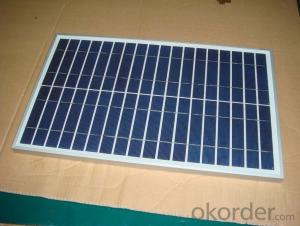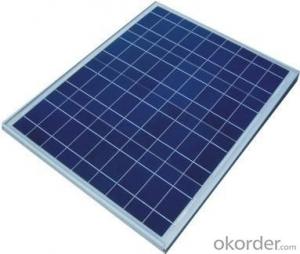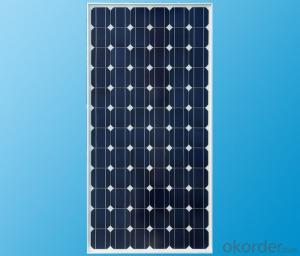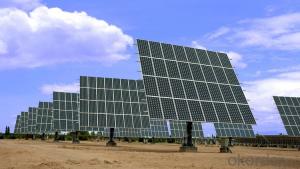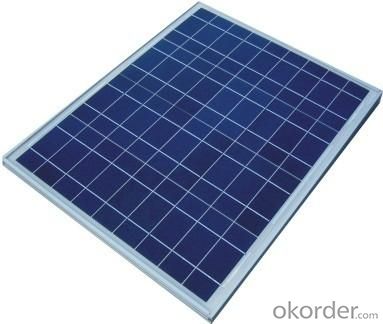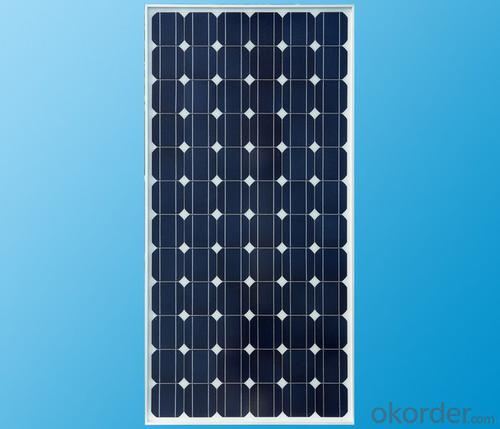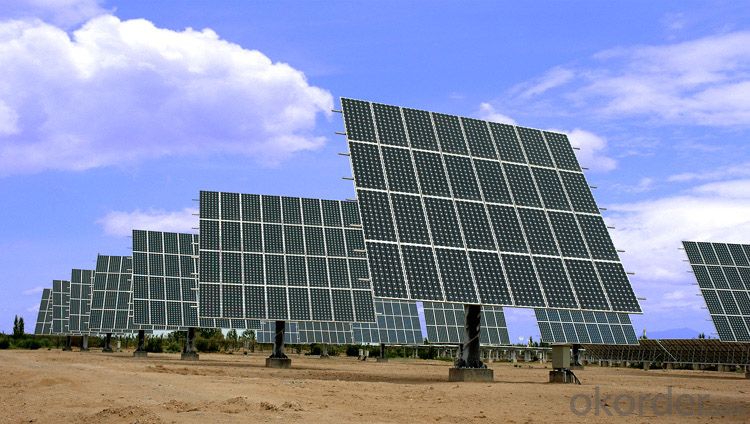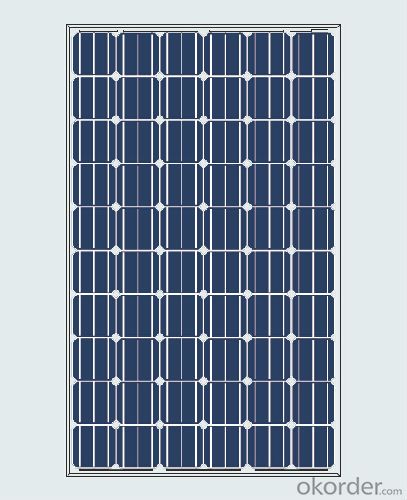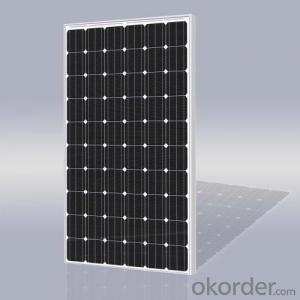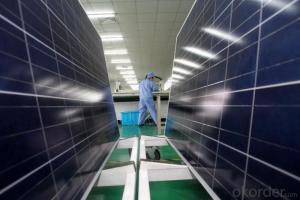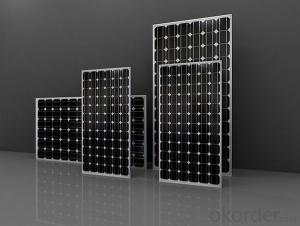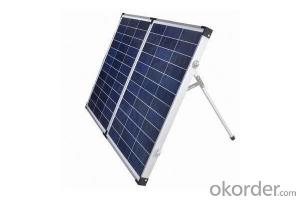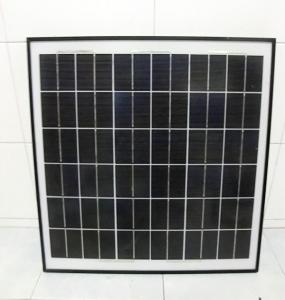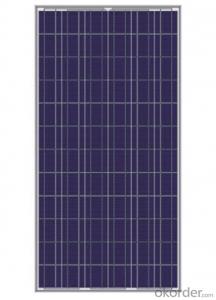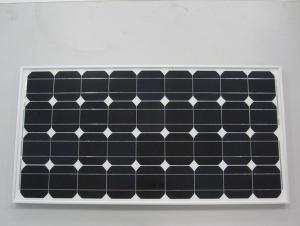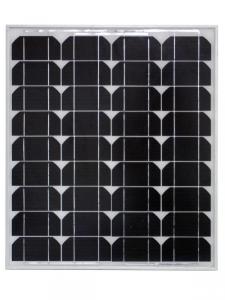Solar Panels Netherlands:Mono Solar Panel with TUV, IEC, CSA, CEC, MCS, CE, ISO Certifications 235W-255W
- Loading Port:
- China main port
- Payment Terms:
- TT or LC
- Min Order Qty:
- 1 pc
- Supply Capability:
- 10000000 pc/month
OKorder Service Pledge
OKorder Financial Service
You Might Also Like
1.Structure of Solar Module Description
CNBM Solar's photovoltaic module is designed for designed for large electrical power requirement. It is the optimal choice for both on-grid and off-grid power systems. CNBM Solar offers high performance of power per square foot of solar array.
2.Main Features of the Solar Module
Solar Cell: High efficency crystalline solar cell. Even if under the weak light, the solar module can produce maximum power output.
Tempered glass: Anti-reflecting coating and high transmission rate glass increase the power output and mechanical strength of solar module.
EVA and TPT: Using high quality EVA and TPT to prevent destroying and water.
Strong aluminum frames to strengthen the load hold and to stand against high wind.
Junction box: Multi function junction box with water proof.
Long lifetime: ≥25 years; Less power decrease.
Good performance of preventing from atrocious weather such as wind and hails.
Resisting moisture and etching effectively, not effected by geology.
The certificate issued by international authority: UL, TUV, IEC, VDE, CE.
Quick Details
| Place of Origin: | Zhejiang China (Mainland) | Brand Name: | DEJIE | Model Number: | DJ-SP |
| Material: | Polycrystalline Silicon | Size: | 54*31*2.8mm | Number of Cells: | 10pcs |
| Max. Power: | 0.17w | materials: | epoxy resin |
Packaging & Delivery
| Packaging Detail: | Bubble bag outer Carton |
| Delivery Detail: | 10days |
3.Solar Module Images
4.Solar Module Specification
1: Long Service Life
2: High Efficiency Solar Cells
3:RoHS/CE
4:High Intensity PCB Board
5: Customized Size and Paramete
low price 0.1w to 3w mini small solar panel
Epoxy solar panel structure
It is a traditional type small solar panel called epoxy resin encapsulated solar panel, which is sticked together by epoxy resin glue at a temperature 50~60 degree, you will see the epoxy resin coated panel have three layers,
1. Epoxy Resin AB Glue
2. Solar Cells
3. PCB Board
Features
1): Epoxy resin solar panel is made of monocrystalline or polycrystalline silicon. The encapsulation material are made of Epoxy Resin. Characterized by anti-humidity, insulation, excellent transparence and anti-aging, as well as smoothness, no bubble and neat apperance. Hard appearance; long-time life, high-performance to week light; widely used in lamp series, no power source sector.
2): Epoxy resin solar panels are easily to install; friendly environmental. High efficiency solar cells, Non-stick protective film.
3):Epoxy resin solar panels can be widely used in solar lawn lamps, solar toys, solar chargers and solar signal lights.
Epoxy Resin Solar Panel Manufacturing Process:
Cut—Assemble—Test—Epoxy Resin—Vacuumize—Bake—Inspect—Coating
Why Choose us?
Have a very strong and professional QC and selling Team
OEM Service Offered/Design Service Offered/Buyer Label Offered
Factory supplier directly
welcome to visit our factory
5.FAQ of Solar Module
1. Q: Do you have your own factory?
A: Yes, we have. Our factory located in Jiangyin city, jiangsu province.
2. Q: How can I visit your factory?
A: Before you take off from your country, please let us know. We will show you the way,or arrange time to pick you up if possible.
3. Q: Do you provide free sample?
A: Usually we do not offer free sample
4. Q: Could you print our company LOGO on the nameplate and package?
A: Yes, we can do that.
- Q: what do I need to do to disconnect a solar panel from a battery to protect the panel?
- Know that solar panels almost always incorporate a blocking diode to prevent a battery from back-feeding through an un-illuminated panel. Know that solar panels are usually connected to a battery via an electronic switching charge controller, not directly connected. Know that when a solar panel is open-circuited (disconnected from everything) it's terminal voltage will rise to almost twice it's nominal voltage. (22V is common for a 2V panel), unless it is stored in total darkness.
- Q: So during the day, electricity is on, everything is on and working fine. But at night where there is no sunlight does all the electricity shut down for the night? So there is no light on for me during the night, or I can't watch tv at night? Is it also true that with solar panels, your bills are less expensive. Can someone please tell me these things
- My mum has solar panels and her electricity is still on all the time. If she uses stuff during the day, it doesn't cost her anything, as the panels are generating electricity, but at night if she uses things, then it will cost her coz there's no sun and no electricity being generated. She's still connected to the grid to use electricity but because she's feeding the electricity produced by her solar panels back into the grid the company pays her a certain amount for the no. of Watts that's produced. They cost a lot to install, but as she is generating more than she's using (even taking night time into account) she is being paid more back. e.g. before panels she paid ~?30per month. Now she receives ~?70per month. so she's about ?00 a month better off (coz she's saving the 30 AND being paid the 70 on top of that)! and will therefore gain the money back that she paid in in about 8 years or so. Hope that makes sense!
- Q: what are solar panels?
- A solar panel is a device that collects and converts solar energy into electricity or heat which can be used by (for example) nearby buildings. Solar photovoltaic panels can be made so that the sun's energy excites the atoms in a silicon layer between two protector panels. Electrons from these excited atoms form an electric current, which can be used by external devices. Solar panels were in use over one hundred years ago for water heating in homes. Solar panels can also be made with a specially shaped mirror that concentrates light onto a tube of oil. The oil then heats up, and travels through a vat of water, instantly boiling it. The steam created turns a turbine for power. The basic element of solar panels is pure silicon. When stripped of impurities, silicon makes an ideal neutral platform for transmission of electrons. In silicon’s natural state, it carries four electrons, but has room for eight. Therefore silicon has room for four more electrons. If a silicon atom comes in contact with another silicon atom, each receives the other atom's four electrons. Eight electrons satisfy the atoms' needs, this creates a strong bond, but there is no positive or negative charge. Silicon atoms combine for years to produce a large piece of pure silicon. This material is used on the plates of solar panels. Combining silicon with other elements that have a positive or negative charge can also create solar panels.
- Q: Pretty much, can solar panel's support the entire houses electrical needs generally, because I know sometimes the owner's can sell unused electricity back, any ideas or any ideas on how much the average home uses in kWh
- How okorder Once you know how much you use, and adjust to reduce how much you use, then you have a handle on how much power in panels you need. If you do not mind being grid tied and social engineered, some power utilities have programs to cover some costs of the installation, but still expect to shell out about 30,000 dollars or more, so how long you plan to live at your residence is a factor too. Grid tie is over-rated, but it can be done. To do it legally you need to involve the power company so they can install equipment to shut your equipment off line if they need to work on the power line.
- Q: I'm building a solar panel for the first time and have the tabbed solar cells. I put together 4 strings of 9 cells. And the cells are each 0.55V, 3.6A.Because I'm going to be using the panel indoors and leaning it up against a window pane, I put them in a 24x36 inch poster-size frame. The frame has a plexiglass cover and a thick cardboard backing. My question to you is this. Will the cardboard backing up against the metal underside (positive side) of the solar cells be ok? I don't know if it may catch fire or if holes may burn through when there's full sun.My guess here is it should be ok. But maybe I'm wrong. If I am wrong, or if something should be put in between, please let me know what I should use.Thanks everyone!
- In commercial panels some sort of polymer is often used for backing. With a 2V panel there are 36 cells, which means they can still output about 4V for charging a 2V battery even when hot. The voltage reduces about 2.2mV per degree C per cell. Commercial panels are meant to work up to about 60 degrees C, which is quite normal in the sun. I have found just lying them on the grass the air circulation is reduced, and they get too hot to charge a 2V battery. This means the backing should have good thermal conductivity while being an electrical insulator, as well as mechanical strength. The cells are often encapsulated in a thermosetting plastic first, then laid face down so a liquid polymer can be poured as backing.. I have removed commercial panels from their frames and re-packaged them to work in a very wet environment. I suppose cardboard would work, but it is unlikely to have good cooling so the expected voltage would be lower. As you intend to only operate indoors I suppose it is unlikely you have full sun most of the time anyway, so there could be less heating and less output current accordingly. I think the cardboard is only useful for a short time, and is not strong enough. Temperature wise it is marginal. The link below uses plywood for the backing. The backing is supposed to provide strength too. A sheet of some sort of plastic or laminate (including melamine laminate as in kitchen bench tops) comes to mind too. The cells are supposed to be bonded to the backing for better thermal conductivity. Use silicon RTV to stick cells to the backing, very thinly.
- Q: Can solar panels be installed on a canopy or pergola?
- Yes, solar panels can be installed on a canopy or pergola. In fact, these structures can provide an ideal location for solar panel installation, as they offer ample space and optimal sunlight exposure. By integrating solar panels into canopies or pergolas, you can generate clean and renewable energy while simultaneously providing shade or protection from the elements.
- Q: How do solar panels affect the property's long-term financial viability?
- Solar panels can have a positive impact on a property's long-term financial viability due to various factors. Firstly, solar panels can significantly reduce or eliminate electricity bills, leading to long-term savings on energy costs. Additionally, with the potential to generate excess electricity, property owners can sell the surplus back to the grid, generating additional income. Moreover, solar panels can increase the value of a property, as they are considered a desirable and environmentally-friendly feature. Lastly, with the growing adoption of renewable energy, properties with solar panels are likely to attract more potential buyers or tenants, enhancing the property's marketability and ensuring long-term financial stability.
- Q: I was looking at thin flexible solar panels as solar panels 500w a option to upgrade a 20w solar panel I have permanently mounted to the roof of a home made camper van.Why I was thinking flexible is at just 2mm thin they can be glued down and being flexible they will follow the contour of the rounded shape of the roof of my camper (boxy standard solar panel spoils the lines a little)Another reason is no glass to brake when traveling on dirt tracks(though I am surprised mine hasn't broken yet after thousands of km on corrugated dirt roads). Finally there is a weight saving at only /3 the weight or less then a standard glass panel.There are different grades of flex PV some of the more expensive ones are very flexible with extremely thin backing at around .5mm The ones I was looking at are cheaper and at around 2mm with a thin flexible aluminum backing.$250 is about the going rate for 20w OKorder job. Below is a pic of a smaller one 60w or so.Has anyone had any experience with them?
- but it's very interesting and I wanted to ask you. In your case this is good solution, but I saw flexible panels in OKorder much cheaper than 250$. This is the price of standard solar panel 20w. Maybe your panels with better efficiency? I know that flexible panels are less than half efficient than regular panels, thats why you need twise more area to get the same output. What is your usage of this energy in this van? I know there are many ideas of solar cars, but if this solution is efficent enough today? Thanks!
- Q: I want to know that, is there any thing likehow much charge we can get per square feet. in a solar panel.let me know.also, I will appreciate if reference are given.
- Solar okorder
- Q: Can solar panels be used to power a sports stadium?
- Yes, solar panels can be used to power a sports stadium. By installing a sufficient number of solar panels on the roof or in nearby areas, a sports stadium can generate renewable energy to meet its electricity needs. This can help reduce reliance on traditional energy sources, lower operating costs, and contribute to a more sustainable and environmentally friendly venue.
Send your message to us
Solar Panels Netherlands:Mono Solar Panel with TUV, IEC, CSA, CEC, MCS, CE, ISO Certifications 235W-255W
- Loading Port:
- China main port
- Payment Terms:
- TT or LC
- Min Order Qty:
- 1 pc
- Supply Capability:
- 10000000 pc/month
OKorder Service Pledge
OKorder Financial Service
Similar products
Hot products
Hot Searches
Related keywords
